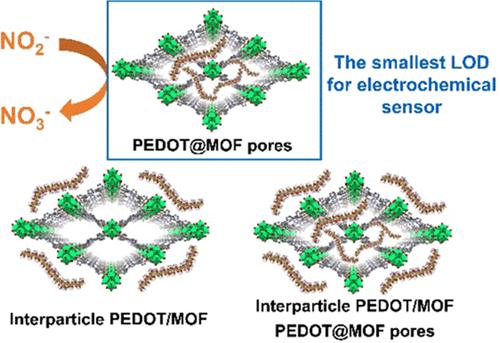当前位置:
X-MOL 学术
›
ACS Appl. Nano Mater.
›
论文详情
Our official English website, www.x-mol.net, welcomes your
feedback! (Note: you will need to create a separate account there.)
Selectively Confined Poly(3,4-Ethylenedioxythiophene) in the Nanopores of a Metal–Organic Framework for Electrochemical Nitrite Detection with Reduced Limit of Detection
ACS Applied Nano Materials ( IF 5.3 ) Pub Date : 2022-08-24 , DOI: 10.1021/acsanm.2c02790
Meng-Dian Tsai, Yi-Ching Wang, You-Liang Chen, Yu-Hsiu Chen, Cheng-Hui Shen, Chung-Wei Kung
ACS Applied Nano Materials ( IF 5.3 ) Pub Date : 2022-08-24 , DOI: 10.1021/acsanm.2c02790
Meng-Dian Tsai, Yi-Ching Wang, You-Liang Chen, Yu-Hsiu Chen, Cheng-Hui Shen, Chung-Wei Kung

|
Poly(3,4-ethylenedioxythiophene) (PEDOT) selectively generated in the nanopores of a zirconium-based porphyrinic metal–organic framework (MOF), NU-902, is synthesized by in situ polymerization with the coexistence of MOF crystals and excessive poly(sodium 4-styrenesulfonate) (PSS) followed by the successive washing steps to remove the well-dispersed PEDOT:PSS from the MOF-based solid. For comparison, PEDOT-NU-902 composite with PEDOT solely present between MOF crystals and that containing both pore-confined PEDOT and interparticle PEDOT are also synthesized by physical blending method and the in situ polymerization without adding PSS, respectively. Crystallinity, morphology, porosity, and electrochemical behavior of these PEDOT-NU-902 composites are investigated. Since both PEDOT and the porphyrinic linkers of NU-902 are active electrocatalysts for nitrite oxidation, these composites along with the pristine NU-902 and PEDOT are applied for electrochemical nitrite sensors in aqueous electrolytes. The composite with PEDOT solely confined within the MOF pores can effectively reduce the nonfaradaic current originating from PEDOT while achieving a moderate catalytic faradaic current for nitrite, which results in its smallest limit of detection (LOD) for nitrite determination compared to other PEDOT-NU-902 composites and the pristine materials. The electrochemical nitrite sensor based on pore-confined PEDOT achieves a sensitivity of 133 μA/mM cm2, a linear range of up to 1.6 mM, and a LOD of 1.71 μM. By utilizing nitrite detection as a proof-of-concept demonstration here, the findings suggest the unique role of the pore-confined conducting polymers within structurally rigid MOFs in electrochemical sensors and shed the light on the design and applications of such nanocomposites for a range of electroanalytical purposes.
中文翻译:

金属-有机框架纳米孔中的选择性限制聚(3,4-亚乙基二氧噻吩)用于电化学亚硝酸盐检测,检测限降低
聚(3,4-乙烯二氧噻吩) (PEDOT) 在锆基卟啉金属-有机骨架 (MOF) 的纳米孔中选择性生成,NU-902 是通过原位聚合合成的,MOF 晶体和过量的聚 ( 4-苯乙烯磺酸钠)(PSS),然后进行连续的洗涤步骤以从基于 MOF 的固体中去除分散良好的 PEDOT:PSS。为了比较,PEDOT仅存在于MOF晶体之间的PEDOT-NU-902复合材料以及同时包含孔受限PEDOT和颗粒间PEDOT的PEDOT-NU-902复合材料也通过物理共混法和原位合成分别在不添加 PSS 的情况下聚合。研究了这些 PEDOT-NU-902 复合材料的结晶度、形态、孔隙率和电化学行为。由于 PEDOT 和 NU-902 的卟啉接头都是亚硝酸盐氧化的活性电催化剂,因此这些复合材料与原始的 NU-902 和 PEDOT 一起用于水电解质中的电化学亚硝酸盐传感器。仅将 PEDOT 限制在 MOF 孔内的复合材料可以有效降低源自 PEDOT 的非法拉第电流,同时实现适度的亚硝酸盐催化法拉第电流,与其他 PEDOT-NU- 相比,这导致其对亚硝酸盐测定的最小检测限 (LOD) 902 复合材料和原始材料。基于孔受限PEDOT的电化学亚硝酸盐传感器实现了133 μA/mM cm的灵敏度如图2所示,线性范围高达1.6 mM,LOD为1.71 μM。通过利用亚硝酸盐检测作为概念验证演示,研究结果表明了孔限制导电聚合物在结构刚性 MOF 中在电化学传感器中的独特作用,并阐明了这种纳米复合材料在一系列领域的设计和应用。电分析目的。
更新日期:2022-08-24
中文翻译:

金属-有机框架纳米孔中的选择性限制聚(3,4-亚乙基二氧噻吩)用于电化学亚硝酸盐检测,检测限降低
聚(3,4-乙烯二氧噻吩) (PEDOT) 在锆基卟啉金属-有机骨架 (MOF) 的纳米孔中选择性生成,NU-902 是通过原位聚合合成的,MOF 晶体和过量的聚 ( 4-苯乙烯磺酸钠)(PSS),然后进行连续的洗涤步骤以从基于 MOF 的固体中去除分散良好的 PEDOT:PSS。为了比较,PEDOT仅存在于MOF晶体之间的PEDOT-NU-902复合材料以及同时包含孔受限PEDOT和颗粒间PEDOT的PEDOT-NU-902复合材料也通过物理共混法和原位合成分别在不添加 PSS 的情况下聚合。研究了这些 PEDOT-NU-902 复合材料的结晶度、形态、孔隙率和电化学行为。由于 PEDOT 和 NU-902 的卟啉接头都是亚硝酸盐氧化的活性电催化剂,因此这些复合材料与原始的 NU-902 和 PEDOT 一起用于水电解质中的电化学亚硝酸盐传感器。仅将 PEDOT 限制在 MOF 孔内的复合材料可以有效降低源自 PEDOT 的非法拉第电流,同时实现适度的亚硝酸盐催化法拉第电流,与其他 PEDOT-NU- 相比,这导致其对亚硝酸盐测定的最小检测限 (LOD) 902 复合材料和原始材料。基于孔受限PEDOT的电化学亚硝酸盐传感器实现了133 μA/mM cm的灵敏度如图2所示,线性范围高达1.6 mM,LOD为1.71 μM。通过利用亚硝酸盐检测作为概念验证演示,研究结果表明了孔限制导电聚合物在结构刚性 MOF 中在电化学传感器中的独特作用,并阐明了这种纳米复合材料在一系列领域的设计和应用。电分析目的。




































 京公网安备 11010802027423号
京公网安备 11010802027423号